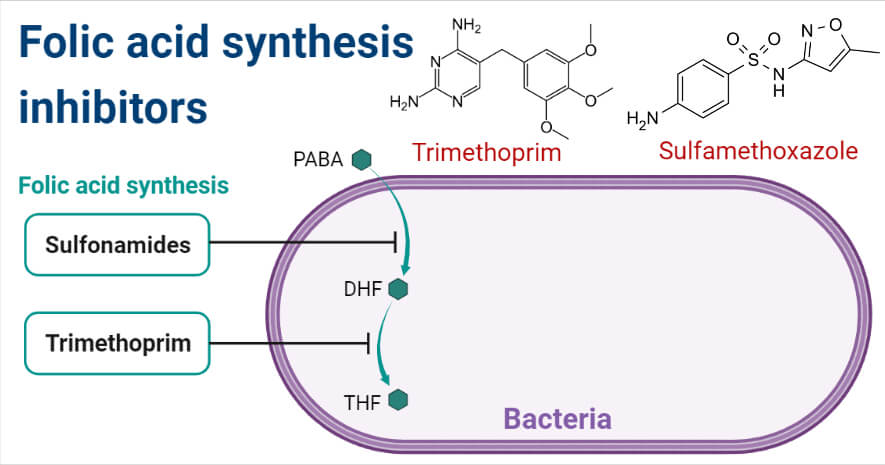Folic acids are the enzymes that are necessary for bacterial protein synthesis and the synthesis of amino acids. Trimethoprim and Sulfonamides are the antimicrobial classes that interfere with the synthesis of folic acid at different levels and are bacteriostatic. Trimethoprim and Sulfonamides are used as combination therapy in treating different infections like Traveller’s Diarrhoea, UTI, etc, due to their synergistic mechanisms. Sulfonamides are widely used antimicrobials that are used because of their efficacy. Trimethoprim prevents bacterial DNA synthesis that inhibits bacterial dihydrofolate reductase (DHFR). Sulfonamides are also antifolate drugs that are categorized into highly soluble, poorly soluble, potentiated, and topical sulfonamides. Trimethoprim is effective against Gram-negative bacteria.

Interesting Science Videos
Mechanism of action of Folic acid synthesis inhibitors
Sulfonamides
They are structurally correspondent to PABA (para-aminobenzoic acid), which inhibits dihydropterate synthetase. They are the substances that substitute PABA that results in the blocking of enzymes that are essential for the biosynthesis of metabolic reactions for RNA formation. Inhibition of growth and replication occurs that cannot use dietary folate, which shows bacteriostatic activity.
Trimethoprim
Trimethoprim is bactericidal. It inhibits an enzyme dihydrofolate reductase. Dihydrofolate reductase is the main enzyme that catalyzes the formation of THF (Tetrahydrofolic acid). This drug binds with dihydrofolate reductase, interfering biosynthesis of nucleic acids and proteins, resulting in bacterial lysis.
Examples of Folic acid synthesis inhibitors
Sulfonamides: Sulfadiazine, Sulfamethoxazole, Sulfadoxine
Trimethoprim: Bactrim
Mechanism of resistance of Folic acid synthesis inhibitors
Sulfonamides
Sulfonamide resistance is mainly due to genes that are located either chromosomally or in the plasmid. Alteration of protein is the common mechanism that causes resistance which reduces the affinity of drugs. Plasmid-mediated genes cause mutation in the dihydrofolate reductase, and chromosomally-mediated genes cause resistance in dihydropterate synthetase. Plasmid-mediated resistance mainly occurs in Gram-negative bacteria that affect the intestine and aid in causing tetracycline and ampicillin resistance. Cross-resistance between sulfonamides and excessive production of PABA that inhibits dihydropterate synthetase are also some reasons for sulfonamide resistance.
Trimethoprim
Resistance to trimethoprim is caused due to various reasons like alteration of the bacterial cell wall and overproduction of dihydrofolate reductase.
References
- From, Trimethoprim: Uses, Interactions, Mechanism of Action | DrugBank Online
- From, Sulfonamides and Sulfonamide Combinations – Pharmacology – Veterinary Manual
- Gene M (1962). Synthesis of Folic Acid. Journal of Biological Chemistry, 237(2): 536–540. https://doi.org/10.1016/S0021-9258(18)93957-8
- Gleckman R, Blagg N, Joubert D W and Pharm, M. S. (n.d.). Trimethoprim : Mechanisms of Action, Antimicrobial Activity, Bacterial Resistance, Pharmacokinetics, Adverse Reactions, and Therapeutic Indications. 14–19.
- Walzer P D, Kim, C. K, Foy J M., Linke, M J and Cushion M T (1988). Ii. 32(1): 96–103.
